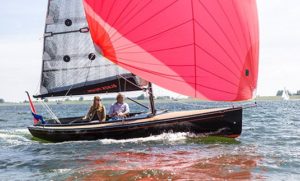ICOMIA CePe Anti-fouling crisis documents

According to an ICOMIA document, no or limited access to effective Anti-fouling paints may jeopardize the EU Yacht and Marine Leisure Industry.
The choices on the evaluation scenarios that national authorities make for evaluating the risks of antifouling paints may have a huge negative impact on the yacht and its related leisure industry.
Executive Summary
The EC is about to finish its lengthy review process of the biocides for antifouling paints. That moment marks the start for the national authorities to use the same method as the EC for the evaluation of products containing these biocides. Although it is the intention of the Biocide Product Regulation (BPR) to harmonize the evaluations between member states it is no guarantee that this will happen for antifouling products, while for their evaluation there is no mutual understanding on the choice of evaluation conditions. It may be perceived that their coastal waters may be different and that they should choose different protection goals. But if for example ‘inside of marina’ will be chosen as scenario, being an environment that should have the same level of protection as more pristine coastal waters, the paint manufacturers and the Yacht industry have a real concern regarding the possibility that none of the current range of antifouling paints for Yachts will pass such risk assessment framework.
We request Member State Competent Authorities in setting their protection goals and the choice of scenarios for risk assessment under the Biocidal Product Regulation to:
– Consider the complete picture with regard to the use of antifouling paints – Take a balanced view of the issue, ensuring that the broader environmental concerns (pollution of waters with non-indigenous species) are addressed, along with the impact on the economy and social effects – Define protection goals that are sensible and realistic – Evaluate antifouling coatings under ‘outside of marina’ conditions, and not to apply the ‘inside of marina’ risk assessment approach – Ensure that there is no ‘double-counting’ of emissions, in particular with regard to the emissions caused by the application and removal of antifouling paints (covered by other regulations)
In our opinion, this will still provide a protective framework to minimise the impact of the use of antifouling paint whilst maximising the benefits of environmental protection afforded by their use.
Using overly conservative safety measures would deprive the EU Yacht industry the access to effective Antifouling paints. This would lead to making the EU yacht industry less competitive and having tourist regions with marine leisure activities facing a reduced income. This may potentially impact the manufacturing and maintenance industry (32,000 companies; many being SMEs), 280,000 direct employees and annual turnover of €20 billion. And also the leisure industry that lives from the some 6 million owners of recreational boats and runs some 4500 marinas.
We invite the national authorities to start a dialogue with our industry on ‘setting scenarios for evaluation of antifouling paints’.
EXPLANATION of the issue
The authorisation under BPR
Approvals for biocides and the subsequent approvals for biocidal products take place as follows. The producer of what is called the ‘active substance’ (read the biocide) submits his dossier to the Competent Authority of the EU Member State’s Competent that is appointed by the EU’s Biocide Committee to deal with that particular biocide. Once ‘approved’ and EU listed a downstream user (like an Anti-Fouling paint producer) can then submit his dossier for a ‘biocidal product’ at the competent authority of one or more EU Member States that are relevant to his market. His biocidal product can only contain approved biocides. With performing the risk assessments for such authorizations for anti-fouling paints the national authorities can choose the marina scenario (marina or outside) and also may determine their own acceptable risk (protection goal). It is this what the yacht industry and the paint manufacturers fear will lead to a reduced number of approvals and will certainly hinder the mutual recognition between EU members states.
Industry comments on Risk Assessment and protecting the EU waters
The Biocidal Product Regulation ((EU) No.528/2012 (BPR)) has been established to build upon the ideas originally laid out under the Biocidal Product Directive (98/8/EC), to put in place a harmonised approach to the approval and authorisation of active substances and biocidal products across the EU. The regulation also aims to establish a high level of environmental protection to ensure that the European environment is not adversely affected by the use of such biocidal products. To this end a comprehensive framework of guidance has been established that specifies how products and active substances should be evaluated in order that risk assessments can be undertaken for the products in question. The precautionary principle prevails in the work of the risk assessor throughout this process, and we have seen the valid application of this approach at many levels of the review programme for Active Substances. Now that the review period for the Active Substances draws to a close the same framework of evaluation is now to be applied to product authorisation. On the basis of the current assumptions and decisions made for Active Substances, some very real concerns have developed regarding the possibility that none of the current range of antifouling products available in the EU will pass the current risk assessment framework.
It must be acknowledged that the use of antifouling paints in the EU provide benefits to the EU economy and environment, which are currently not accounted for as part of the evaluation process. Quite correctly the Member States undertake the risk assessments in accordance with the risk assessment guidance, but there is no mechanism for a holistic approach to be applied, whereby the benefits of using biocidal antifouling products can be considered along with the potential impact on the marina environment in which they are released.
The risk assessment requires that all sources of the biocide released to the environment are accounted for, specifically those potential emissions from application and removal of products at large Yacht yards. Whilst this is a reasonable proposition there is a danger that such assumptions ‘double count’ the risk, as those waste emissions are already heavily regulated according to the rule laid out under the Industrial Emissions Directive and daughter regulations beneath it. Such emissions are controlled by the integrated pollution, prevention and control regulations (IPPC), which are enforced locally in all EU Countries by issuance of permits controlling emissions. Historically the BPD set out not to overlap with other enforcing regulations. On the face of it this would be one such example.
The potential socio economic impact
Anti-fouling paints are applied when building a yacht (by professionals only) and when maintenance is required. Normally professionals apply these paints on large yachts and the DIY-er on small boats. The effect that the current risk assessment paradigm will have on existing products is expected to lead to a loss of AF paints on the market.
The net impact of the above described approaches to the control of antifouling products will result in a reduction of products with a high efficacy for reducing invasive species and reducing drag (which translates in an increase of greenhouse gas). The users of AF paints would look across borders to get their effective products. Hoping that the applying of AF coatings to leisure craft will not move across the borders (either the external EU border or the internal borders from one member state to another where the AF paint did receive an approval).
For large expensive yachts the antifouling paints provide the key product necessitating a scheduled maintenance. If these products are not available yachts can easily be redirected to dock facilities outside of the control of the EU authorities (or EU member state?), where the key anti-fouling products are available. All the other accompanying maintenance and repair business would move with it. This lack of product availability will affect the yacht industry in the EU as a whole. The effect of this migration of business away from the EU will be dramatic on an industry, which today which is a key contributor to the European economy.
And still the environmental objectives would not be met, or potentially be worse, as ships coated with antifouling paints lacking an EU approval will still travel to EU ports.
Possible solutions
Member state authorities are now being challenged with defining the protection goals of their countries. Industry would prefer a harmonised approach with respect to whether marinas should have the same level of protection as shipping lanes in the open sea. The Technosphere concept should be considered in the context of protecting these predominantly man made environments and re-evaluation of their value in supporting a significant EU industry. By setting a more realistic level of protection for these environments increased protection will be afforded to the wider environment through the continued use of antifouling coatings, protecting against possible invasive species and reducing atmospheric emissions. Control processes in other national or EU legislation should be factored into the risk assessment, to account for control techniques used to mitigate the release of waste paint. Such to prevent that there is ‘double counting’ of emissions.
The letter is signed by Jan van der Meulen for CEPE and Udo Kleinitz for ICOMIA










